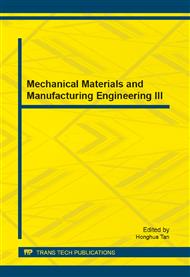[1]
HU Chengwu, ZOU Anquan. The Optimum Taper Angle of Intaglio Mould When Two-piece Cans Thinned and Drawn[J]. Packaging and Food Machinery, 1998, 16(3): 7-9.
Google Scholar
[2]
ZHANG Baohong, ZHANG Zhimin, ZHANG Xing, et al. Numerical simulation of warm drawing of cup[J]. Journal of Plasticity Engineering, 2004, 11(3): 86-88.
Google Scholar
[3]
WANG Qianting, CHEN Wenzhe, WANG Huosheng, et al. Thinning drawing simulation of can body stock[J]. Mechanical & Electrical Technology, 2010, (Z): 43-45.
Google Scholar
[4]
Luis Fernando Folle, Sergio Eglan Silveira Netto, Lirio Schaeffer. Analysis of the manufacturing process of beverage cans using aluminum alloy[J]. Journal of Materials Processing Technology, 2008, 205(1-3): 347-352.
DOI: 10.1016/j.jmatprotec.2007.11.249
Google Scholar
[5]
HU Chengwu, WANG Juhuai. Cone Angle of Female Die of Two-Piece Can in Thinning Drawing Based on the Minimum Resistance of Deformation[J]. China Metal Forming Equipment & Manufacturing Technology, 2005, 40(2): 90-92.
Google Scholar
[6]
WANG Jia, ZHANG Zhimin. Optimization of Matrix Cone Angle by Computer Simulation In Ironing Technology[J]. Die & Mould Industry, 2002, (4): 17-19.
Google Scholar
[7]
Xu Jiangping, Liu Yuqi, Zhang Zhibing, et al. Optimization of Process Parameters of Thick Metal Plate Ironing[A]. Proceedings of the Tenth National Symposium on Plasticity and the Third International Symposium on Advanced Technology of Plastic Processing[C]. 2007: 853-856.
Google Scholar
[8]
WU Xianghong, ZHAO Guoqun, MA Xinwu, et al. Study of Influence of Die Angle on Extrusion Process of Profile Aluminium[J]. China Metal Forming Equipment & Manufacturing Technology, 2005, 40(5): 75-78.
Google Scholar
[9]
Zhan Yanran, Z. R. Wang, Chen Weimin. Numerical simulations for extrusion and ironing and die-angle optimization[J]. Journal of Materials Processing Technology, 1995, 55(1): 48-52.
DOI: 10.1016/0924-0136(95)01811-5
Google Scholar
[10]
Liu Chao, Dong Yuping, Wu Yunyu. Study of Mold Cone Angle of Hydraulic Briquetting Press Based on ANSYS[J]. Transactions of the Chinese Society for Agricultural Machinery, 2009, 40(12): 125-129.
Google Scholar


